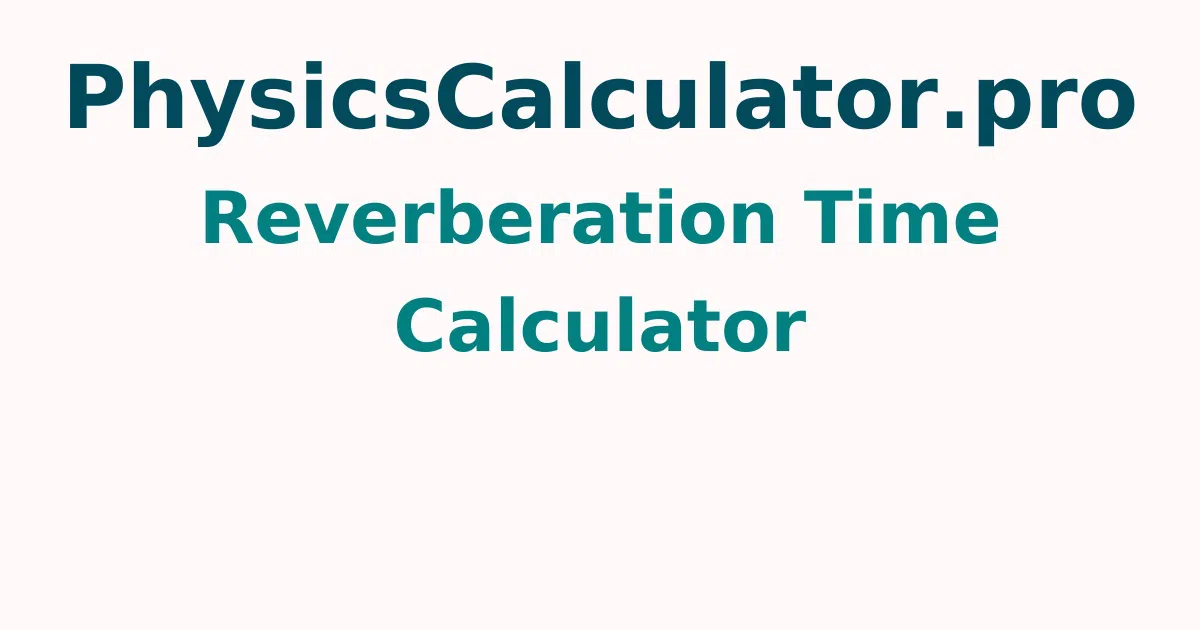Reverberation Time Calculator
This free Reverberation Time Calculator may be used to calculate the reverberation time of a room in seconds and provides a full explanation. Enter the room length, room height, room width, doors, windows, height, width, and the number of windows, doors in that room in the input fields and click calculate to quickly get the reverberation time and effective absorption area.
What is Reverberation Time?
Every sound is nothing more than a wave moving through space, whether in the air or through another medium. When a sound wave is produced in a room, it propagates ahead until it encounters an obstruction. The sound wave is obstructed by every room boundary, such as the wall, ceiling, and window.
Two things occur when the wave collides with the obstruction. To begin, the barrier absorbs some of the wave energy, which normally results in heat exchange. Second, the wave is reflected by the impediment and starts travelling in the other direction.
After a certain amount of time, the sound is reflected so many times that the majority of the energy is absorbed. The sound pressure level (SPL) drops as a result of this. The reverberation time is the time between sound production and the moment when the SPL drops to 60 dB. Because reverberation is greatly influenced by sound frequency, it must be carefully considered while planning an architectural design.
RT60 Equation
The reverberation time can be measured in two ways. The first is to utilise a piece of specialised equipment, such as a level recorder that can graph SPL with time. The alternative option is to calculate it based on the room's parameters.
The RT60 equation is a formula that empirically establishes the relationship between reverberation time and room absorptive qualities. It's able to write it as RT60 = 0.163 * V/A
Effective absorbing area formula is A = α₁S₁ + α₂S₂ + ... + αₐSₐ
- Where, V = total volume of the room
- A = effective absorbing area of the room
- RT60 = reverberation time
- S = area of the specific part of the room surface
- α = absorption coefficient of the surface
Formulas for determining the Optimal Reverberation Time
The following are several purposes for determining the best reverberation time.
Communication T = 0.32 * log V - 0.17
Music performance T = 0.45 * log V + 0.17
Speech T = 0.37 * log V - 0.14
Music rehearsel T = 0.47 * log V - 0.37
For more concepts check out physicscalculatorpro.comto get quick answers by using the free tools available.
How to Calculate Reverberation Time?
Take a look at the step-by-step instructions for determining a room's or auditorium's reverberation time. There are two ways to calculate the reverberation time. One uses a device, while the other relies on the size of the room. When using room parameters to calculate reverberation time, the RT60 equation works well. Obtain the steps and carefully follow them.
- Step 1: Get the room's size, as well as the dimensions of the doors and windows.
- Step 2: Calculate the room's volume by multiplying its length, breadth, and height.
- Step 3: Calculate the area of the component of the room's surface multiplied by the absorption coefficient.
- Step 4: To calculate the effective absorption area, add all of the products together.
- Step 5: By dividing the volume by the effective absorbing area, you may get the effective absorbing area.
- Step 6: To get the RT, multiply the result.
FAQs on Reverberation Time
1. What is reverberation time?
The time it takes for a sound to decay by 60 decibels is known as reverberation time, and it is abbreviated as T60 or RT60. For optimum speech clarity, a reverberation period of fewer than 0.5 seconds is desirable.
2. How can reverberation time be reduced?
Sound waves bounce off smooth surfaces. As a result, soft and absorbent surfaces should be used in space. The RT60 of smaller rooms is lower.
3. How long should the reverberation time be?
In reality, a room's allowable reverberation time is determined by its intended usage. For a medium-sized auditorium that is utilised for both music and speech, and RT60 of roughly 2 seconds is ideal. For a classroom, T0 should be less than 1 second, and for recording studios, it should be even shorter. Finally, the absorption coefficient of the surface influences reverberation time.
4. What is Sabine's reverberation time formula?
As a result, the reverberation time is TR = 36 V/cA. This approximation formula closely resembles the result obtained experimentally by W. C. Sabine and later refined by W. S. Franklin.
